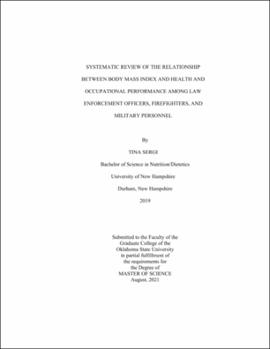| dc.contributor.advisor | Joyce, Jill | |
| dc.contributor.author | Sergi, Tina | |
| dc.date.accessioned | 2022-01-09T19:37:53Z | |
| dc.date.available | 2022-01-09T19:37:53Z | |
| dc.date.issued | 2021-08 | |
| dc.identifier.uri | https://hdl.handle.net/11244/333647 | |
| dc.description.abstract | Background: The prevalence of overweight and obesity can reach 70-75% among tactical populations, which could negatively impact health and performance. The relationship between BMI and health and performance is well established among the general population, however literature on such relationships among tactical populations has yet to be collectively reviewed, summarized, and evaluated. Thus, the purpose of this systematic review was to review available literature on the relationship between BMI and health and performance among law enforcement, firefighters, and military personnel. | |
| dc.description.abstract | Methods: Literature searches were conducted in PubMed and SCOPUS using combinations of search terms: body mass index, health*, cardiovascular disease, heart disease, heart attack, myocardial infarction, heart failure, stroke, hypertension, cancer, diabetes, performance, physical fitness test*, physical training, fitness test*, injury*, law enforcement, police, trooper, firefighter, military, soldier, airmen, and sailor. Included studies used BMI as adiposity assessment; involved cardiovascular disease (CVD), cancer, diabetes (T2DM), performance testing, and injuries among law enforcement, firefighters, or military personnel in the US; were peer-reviewed primary research between 2000-2020. Review studies; studies on other tactical populations, retirees, trainees; and studies using BMI as a covariate were excluded. Included articles were critically appraised using the Academy of Nutrition and Dietetics Quality Criteria Checklist. | |
| dc.description.abstract | Results: After screening titles, abstracts, and full-text, 27 articles were included. Overall quality was neutral. Nine studies regarding CVD found that increasing BMI was associated with an increase in CVD risk factors. No cancer studies were included. One study on T2DM found that higher BMI was associated with increased risk of T2DM. Five studies on occupational/physical performance found that higher BMI was often indicative of decreased performance, but results were inconsistent. Twelve studies on injury were inconsistent. Increasing BMI often indicated increased risk of injury but may be protective against stress fractures. | |
| dc.description.abstract | Discussion & Conclusions: Increased BMI was generally associated with negative health and performance outcomes among tactical populations. Public health practitioners should focus efforts on improving nutrition and physical activity to promote a healthy BMI among these individuals. | |
| dc.format | application/pdf | |
| dc.language | en_US | |
| dc.rights | Copyright is held by the author who has granted the Oklahoma State University Library the non-exclusive right to share this material in its institutional repository. Contact Digital Library Services at lib-dls@okstate.edu or 405-744-9161 for the permission policy on the use, reproduction or distribution of this material. | |
| dc.title | Systematic review of the relationship between body mass index and health and occupational performance among law enforcement officers, firefighters, and military personnel | |
| dc.contributor.committeeMember | Hildebrand, Deana | |
| dc.contributor.committeeMember | Dawes, Jay | |
| osu.filename | Sergi_okstate_0664M_17046.pdf | |
| osu.accesstype | Open Access | |
| dc.type.genre | Thesis | |
| dc.type.material | Text | |
| dc.subject.keywords | body mass index | |
| dc.subject.keywords | firefighter | |
| dc.subject.keywords | health | |
| dc.subject.keywords | law enforcement | |
| dc.subject.keywords | military personnel | |
| dc.subject.keywords | performance | |
| thesis.degree.discipline | Nutritional Sciences | |
| thesis.degree.grantor | Oklahoma State University | |
